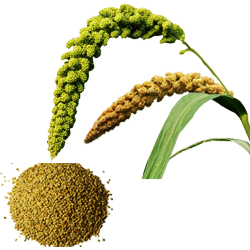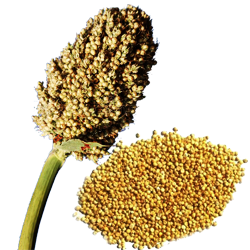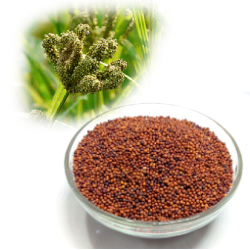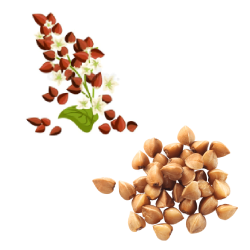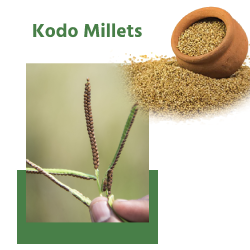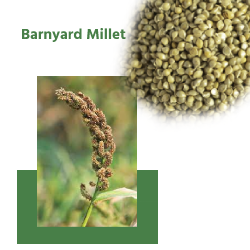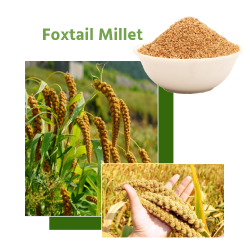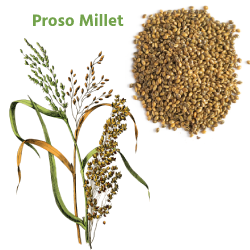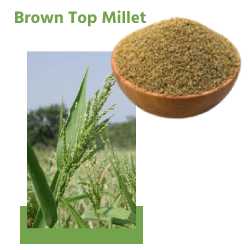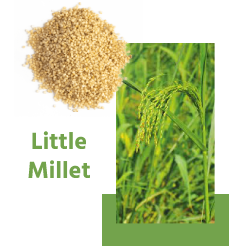Indian Millets
Indian millets (shri ann) are a robust, nutrient-rich grain that thrives in the arid and semi-arid regions of India. Common varieties include finger millet (ragi), pearl millet (bajra) and sorghum (jowar), each of which is known for its high nutritional value and health benefits.
भारत में बाजरे (मिलेट्स) का इतिहास
सदियों से Millets (बाजरा) यानी मोटे अनाज (श्री अन्न) भारत का मुख्य भोजन रहा है, लेकिन धीरे-धीरे ये मोटे अनाज पृष्ठभूमि में चले गए। हरित क्रांति के दौरान, हरित क्रांति के लिए चिह्नित भौगोलिक क्षेत्रों में गेहूं और चावल की उच्च उपज वाली किस्मों का उपयोग करके खाद्यान्नों के उत्पादन और उत्पादकता को बढ़ाने पर जोर दिया गया था, जिसके कारण हरित क्रांति के बाद के दौर में बाजरा पूरी तरह से हाशिए पर चला गया।
बाजरा घास परिवार का एक छोटा दाना वाला वार्षिक ग्रीष्मकालीन अनाज है। भारत में उगाई जाने वाली मुख्य फसलें ज्वार (सोरघम), बाजरा (पर्ल मिलेट) और रागी (फिंगर मिलेट) हैं। लेकिन देश में छोटे आकार के बाजरे भी उगाए जाते हैं जो चीना (प्रोसो), कोदो (कोडरा, अरिकेलु), कंगनी/कोरा (फॉक्सटेल), वरई/सावा (बार्नयार्ड) और कुटकी (लिटिल मिलेट) हैं।
भारत में बाजरे की खेती (Millets Farming)5000 से ज़्यादा सालों से की जाती रही है और यह कई प्राचीन सभ्यताओं का मुख्य भोजन था। दरअसल, ऐसा माना जाता है कि भारत में गेहूं और चावल से पहले बाजरा सबसे पहले उगाया जाने वाला अनाज था। बाजरे को उनके पोषण मूल्य के लिए काफ़ी सराहा जाता था और इसका इस्तेमाल दलिया से लेकर रोटी तक कई तरह के व्यंजनों में किया जाता था।
समय के साथ, जैसे-जैसे आधुनिक कृषि पद्धतियाँ शुरू हुईं, भारत में बाजरे का चलन कम होता गया। किसानों ने गेहूं और चावल जैसी उच्च उपज वाली फसलों पर ध्यान केंद्रित करना शुरू कर दिया, जिनकी खेती करना आसान था और जिनकी बाज़ार में व्यापक अपील थी। बाजरा गरीबी से जुड़ा हुआ था और इसे अक्सर "गरीब आदमी का भोजन" माना जाता था।
हाल ही कुछ के वर्षों में, भारत में बाजरे में नए सिरे से दिलचस्पी बढ़ी है। लोग इन प्राचीन अनाजों के पोषण मूल्य को पहचानने लगे हैं और ज़्यादा टिकाऊ खाद्य विकल्पों की तलाश कर रहे हैं। 2018 में, भारत सरकार ने बाजरे की खेती और खपत को बढ़ावा देने के लिए "राष्ट्रीय बाजरा वर्ष" भी घोषित किया।
भारतीय श्री अन्न (बाजरा) पोषक तत्वों से भरपूर, सूखा-सहनशील फसल है जो ज़्यादातर भारत के शुष्क और अर्ध-शुष्क क्षेत्रों में उगाई जाती है। यह एक छोटी-सी बीज वाली घास की प्रजाति है जो पौधे के जीनस "पोएसी" से संबंधित है। यह लाखों संसाधन-विहीन किसानों के लिए भोजन और पशु चारे का एक महत्वपूर्ण स्रोत है और भारत की पारिस्थितिक और आर्थिक सुरक्षा में महत्वपूर्ण भूमिका निभाता है।
इस श्री अन्न (बाजरा) को "मोटे अनाज" या "गरीबों का अनाज" के रूप में भी जाना जाता है। भारतीय श्री अन्न (बाजरा) पोषण के मामले में गेहूँ और चावल से बेहतर है क्योंकि ये प्रोटीन, विटामिन और खनिजों से भरपूर होते हैं। वे ग्लूटेन-मुक्त भी होते हैं और उनका ग्लाइसेमिक इंडेक्स कम होता है, जो उन्हें सीलिएक रोग या मधुमेह वाले लोगों के लिए उपयुक्त बनाता है।
भारतीय बाजरा: स्वास्थ्य और पोषण के लिए एक व्यापक मार्गदर्शिका
बाजरा छोटे बीज वाली घासों का एक समूह है जिसकी खेती भारत में हज़ारों सालों से की जाती रही है। वे अपने उच्च पोषण मूल्य, विभिन्न मिट्टी और जलवायु परिस्थितियों के अनुकूल होने और कठोर वातावरण में उगने की क्षमता के लिए जाने जाते हैं। हाल ही बीते कुछ के वर्षों में, बाजरा अपने कई स्वास्थ्य लाभों के कारण स्वास्थ्यवर्धक भोजन के रूप में लोकप्रिय हो गया है।
अंतर्राष्ट्रीय मिलेट्स (श्री अन्न) वर्ष 2023: की गई पहल और प्रस्तावित गतिविधियाँ
भारत सरकार ने संयुक्त राष्ट्र को वर्ष 2023 को अंतर्राष्ट्रीय श्री मिलेट्स (श्री अन्न) वर्ष (IYOM) घोषित करने का सुझाव दिया। 5 मार्च 2021 को संयुक्त राष्ट्र महासभा (UNGA) द्वारा 72 अन्य देशों के समर्थन से भारत को वर्ष 2023 को अंतर्राष्ट्रीय मिलेट्स (श्री अन्न) वर्ष घोषित किया गया।
भारत सरकार द्वारा IYOM 2023 मनाने की पहल का उद्देश्य लोगों में मिलेट्स (श्री अन्न) के लाभों के बारे में जागरूकता पैदा करना और देश और दुनिया भर में मिलेट्स (श्री अन्न) के मूल्य संवर्धन की स्वीकृति बढ़ाना है।
अंतर्राष्ट्रीय श्री मिलेट्स (श्री अन्न) वर्ष निम्नलिखित के लिए एक समृद्ध अवसर प्रदान करता है:
- खाद्य सुरक्षा में मिलेट्स (श्री अन्न) के योगदान को बढ़ाना।
- मिलेट्स (श्री अन्न) के वैश्विक उत्पादन को बढ़ाना।
- कुशल प्रसंस्करण, परिवहन, भंडारण और खपत सुनिश्चित करना।
- हितधारकों की भागीदारी के साथ मिलेट्स (श्री अन्न) का सतत उत्पादन और गुणवत्ता।
बाजरा क्या है और वे क्यों महत्वपूर्ण हैं?
मिलेट्स छोटे बीज वाली घासों की एक जाति हैं जो पोएसी परिवार से संबंधित हैं। ये सूखा सहनशील, लचीली और विभिन्न मिट्टी और जलवायु स्थितियों के अनुकूल होती हैं, जिससे इन्हें भारत में उगाना आदर्श बनता है, जहां वर्षा पैटर्न और मिट्टी की गुणवत्ता बहुत भिन्न होती है।
मिलेट्स को साल भर उगाया जा सकता है, खरीफ से लेकर रबी सीजन तक, और साल में कई फसलें प्रदान कर सकते हैं, जिससे ये छोटे और सीमांत किसानों के लिए एक स्थायी और लागत प्रभावी फसल बन जाती हैं।
मिलेट्स लोहा, जिंक और कैल्शियम जैसे माइक्रोन्यूट्रिएंट्स में समृद्ध होते हैं और इनमें ग्लाइसेमिक इंडेक्स कम होता है, जो ग्लूकोज को धीरे-धीरे रक्तप्रवाह में छोड़ते हैं और रक्त शर्करा के स्तर को नियंत्रित करने में मदद करते हैं। मिलेट्स ग्लूटेन-फ्री भी होते हैं, जिससे ये सीलिएक रोग या ग्लूटेन संवेदनशीलता वाले लोगों के लिए उपयुक्त होते हैं।
भारत में कई प्रकार के बाजरे उगाए जाते हैं, जिनमें शामिल हैं:
- फिंगर बाजरा (रागी): फिंगर बाजरा भारत में सबसे ज़्यादा उगाए जाने वाले बाजरे में से एक है, दक्षिणी भारत में यह एक लोकप्रिय बाजरा है, रागी कैल्शियम, फॉस्फोरस और थायमिन का एक अच्छा स्रोत है। इसका उपयोग डोसा, इडली, दलिया और माल्टेड ड्रिंक बनाने के लिए किया जाता है।
- पर्ल बाजरा (बाजरा): बाजरा एक कठोर फसल है जिसे शुष्क और बंजर क्षेत्रों में उगाया जा सकता है। राजस्थान, गुजरात और हरियाणा में मुख्य भोजन, बाजरा प्रोटीन, फाइबर और आयरन से भरपूर होता है। इसका उपयोग रोटी, भाकरी, खिचड़ी और नमकीन बनाने में किया जाता है।
- सोरघम (ज्वार): सोरघम भारत के कई हिस्सों में उगाई जाने वाली एक सूखा-प्रतिरोधी फसल है। इसमें प्रोटीन, फाइबर और एंटीऑक्सीडेंट की मात्रा अधिक होती है, और इसका उपयोग रोटी, दलिया और भाकरी और पापड़ जैसे स्नैक्स बनाने के लिए किया जाता है।
- फॉक्सटेल बाजरा (कांगनी): फॉक्सटेल बाजरा भारत के कई हिस्सों में उगाया जाने वाला एक छोटा अनाज वाला बाजरा है। यह प्रोटीन, फाइबर और आयरन तथा कैल्शियम जैसे खनिजों से भरपूर होता है और इसका उपयोग दलिया, उपमा और डोसा बनाने में किया जाता है।
- लिटिल बाजरा (कुटकी): छोटा बाजरा भारत के कई हिस्सों में उगाया जाने वाला एक छोटा अनाज वाला बाजरा है। यह प्रोटीन, फाइबर और आयरन तथा मैग्नीशियम जैसे खनिजों से भरपूर होता है और इसका उपयोग दलिया, उपमा और डोसा बनाने में किया जाता है।
- कोदो बाजरा (कोदो): भारत के पहाड़ी क्षेत्रों में उगाया जाने वाला एक कठोर बाजरा, कोदो बाजरा प्रोटीन, फाइबर और एंटीऑक्सीडेंट से भरपूर होता है। इसका उपयोग खिचड़ी, उपमा, इडली और पोंगल बनाने में किया जाता है।
- बार्नयार्ड बाजरा (सांवा): भारत के कई हिस्सों में उगाया जाने वाला एक ग्लूटेन-मुक्त बाजरा, बार्नयार्ड बाजरा कैल्शियम, फास्फोरस और आयरन से भरपूर होता है। इसका उपयोग उपमा, पोंगल, खीर और पुलाव बनाने में किया जाता है।
बाजरा का उपयोग बीयर और व्हिस्की जैसे मादक पेय पदार्थों के उत्पादन में भी किया जाता है। अपने पोषण मूल्य के अलावा, बाजरा पर्यावरणीय स्थिरता के लिए भी महत्वपूर्ण है। उन्हें अन्य फसलों की तुलना में कम पानी की आवश्यकता होती है और उन्हें कई तरह की परिस्थितियों में उगाया जा सकता है, जिससे वे सूखाग्रस्त क्षेत्रों में किसानों के लिए एक आदर्श फसल बन जाते हैं।
हाल के वर्षों में, भारत में बाजरे की लोकप्रियता में फिर से उछाल आया है। सरकार ने बाजरे की खेती और खपत को बढ़ावा देने के लिए कई पहल की हैं, और कई रसोइयों और खाद्य उत्साही लोगों ने इन प्राचीन अनाजों के साथ नए और रोमांचक तरीकों से प्रयोग करना शुरू कर दिया है।
भारतीय बाजरा (Indian Millets) के फायदे
भारतीय बाजरा में कई स्वास्थ्य लाभ होते हैं जो इन्हें एक आदर्श आहार बनाते हैं। भारतीय मिलेट्स खाने के कुछ फायदे यहां दिए गए हैं:
- पोषक तत्वों से भरपूर: भारतीय मिलेट्स प्रोटीन, फाइबर, विटामिन और खनिजों का एक समृद्ध स्रोत हैं। ये वसा में कम और ग्लूटेन-फ्री भी होते हैं, जिससे ये सीलिएक रोग या ग्लूटेन असहिष्णुता वाले लोगों के लिए आदर्श भोजन बनते हैं।
- मिलेट्स को कोलेस्ट्रॉल के स्तर को कम करने और रक्तचाप को नियंत्रित करके हृदय रोग के जोखिम को कम करने के लिए जाना जाता है। ये एंटीऑक्सीडेंट्स का भी एक समृद्ध स्रोत हैं, जो हृदय रोग के जोखिम को कम करने में मदद करते हैं।
- वजन घटाने में सहायक:मिलेट्स कैलोरी में कम और फाइबर में उच्च होते हैं, जिससे ये वजन घटाने के लिए आदर्श भोजन बनते हैं। ये आपको लंबे समय तक तृप्त रखते हैं और अधिक खाने से रोकते हैं।
- पाचन में सहायता:मिलेट्स फाइबर में समृद्ध होते हैं, जो स्वस्थ पाचन को बढ़ावा देते हैं और कब्ज को रोकते हैं।
- हृदय स्वास्थ्य को बढ़ावा देना:
Smart farming and agriculture app for farmers is an innovative platform that connects farmers and rural communities across the country.
Explore
Important Link
© All Copyright 2024 by Kisaan Helpline
